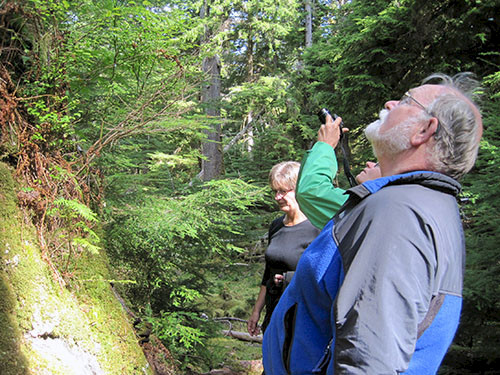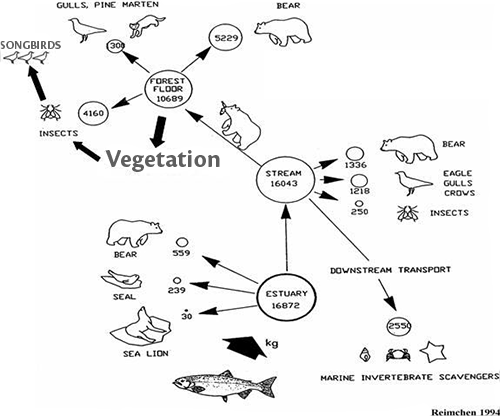Insights on story-telling from the salmon in the tree
Bill Nuttle ·I first heard the story of the salmon in the tree while visiting in Haida Gwaii this summer. Haida Gwaii is a set of islands along the northwest coast of North America that is home to the Haida people, one of several nations of the aboriginal people that have existed here for about 10,000 years. I am an engineer by training, and my traveling companions, my wife Lenore and friends Tom and Nancy, are scientists. In contrast with the Haida, the modern Western culture that we represent has existed for only about 200 years. We spent much of our time on Haida Gwaii exploring differences between these two cultures, but I was most impressed by the way in which both the Haida and Western scientists use story-telling.

Our Haida guides informed us that their culture relies on story-telling to transmit its accumulated knowledge and cultural practices from one generation to the next. These stories are reflected in the distinctive art of the Haida. We heard plenty of wonderful tales from the Haida culture; how the Raven freed the first men from a clam shell; the Bear who stole a woman for his wife; the lost brother who returned as an orca; how people saved themselves from the great flood. Haida mythology is full of tales of spiritual beings who change form. At times these spirits may take on the form of people, and at other times they take the form of various animals iconic of the region, such as the orca, the raven, the eagle, and the bear. The theme of the interconnectedness of all things runs through Haida myth. The Haida flood myth tweaked my interest, and my companions and I discussed at length whether this might refer to a tsunami or the rapid rise in sea level that science tells us must have taken place with melting of the glaciers at the end of the last ice age.

The most interesting story I heard was the story of how the salmon got into the tree. As the story goes, it is the eagle and the bear that are responsible for putting the salmon in the tree. Around the end of summer each year large numbers of salmon arrive from the ocean to spawn in the rivers and streams of the Pacific Northwest. Eagles and bears are waiting when the salmon arrive. Large fish fighting to occupy every space in small streams are easy prey, and the eagles and bears eat their fill. Soon the surrounding forest is littered with the rotting carcases of half-eaten salmon. However, in their death the salmon deliver a gift to the forest. The forest soil is poor where the ocean home of the salmon is rich, and decaying salmon carcases provide nutrients that the trees need to grow and be healthy. In return, the healthy trees protect the streams where the salmon eggs wait to hatch and where the young salmon stay until they grow large enough to return to the ocean to begin the cycle again. Everything is connected.
Although it reads like an ancient Haida myth, the story of the salmon in the tree is a recent product of Western science. Ecologists began piecing together the story of the salmon in the tree about 25 years ago, by first investigating the influence of the annual influx of spawning salmon had on the aquatic ecology in the streams. In 2001, scientists traced the effect of nutrients delivered by the salmon [pdf] on the trees and shrubs in the surrounding forest as well. To do this, scientists used the fact that the nitrogen, an essential nutrient, circulating in marine ecosystems has a distinctly different isotopic signature than the nitrogen found in terrestrial ecosystem. By combining what they know about the role of salmon in the food chain of coastal forest ecosystems with measurements of marine-derived nitrogen in the forest, scientists have found that salmon provide from 25% up to as much as 75% of the nitrogen used by trees growing near spawning streams.

Not only is this a good story on its own, but the story behind the story of the salmon in the tree is a case study of how scientists study the environment. I learned from my friends Tom and Nancy that Thompson Rivers University, where Tom is Dean of Science and Nancy teaches biology, uses the story of the salmon in the tree in their introductory biology course. In the second semester of the course, after students have been taught the basics of biology, students are divided into teams. Each team is assigned to write and present a skit that answers a quirky science question. The question “How did the salmon get into the tree?” kicks off this unit. Questions that students have answered include: “Why does the female hyena have a penis?”; “Why do squirrels’ tails light up?; and “Why are mushrooms like zombies?” In the course of writing and performing their skits, students learn not only the facts of biological science but also how it is done. (Here are some examples of the student presentations.)
Q: How are the dissimilar cultures of the Haida and Western science alike?
A: Both the Haida and Western scientists use stories and story-telling to transmit knowledge and practice from one generation to the next. The particulars of the stories differ. Where the Haida myths describe supernatural spirits that move from one body to the next, ecologists prefer to speak of the flows of nutrients and energy in food webs. However, the power of story-telling transcends cultural differences. Good stories spark curiosity and motivate learning.
References:
Helfield, J.M., and R.J. Naiman, 2001. Effects of salmon-derived nitrogen on riparian forest growth and implications for stream productivity. Ecology, 82: 2403–2409. [pdf]
Reimchen, T. E. 2001. Salmon nutrients, nitrogen isotopes and coastal forests. Ecoforestry 16:13-17. [pdf]